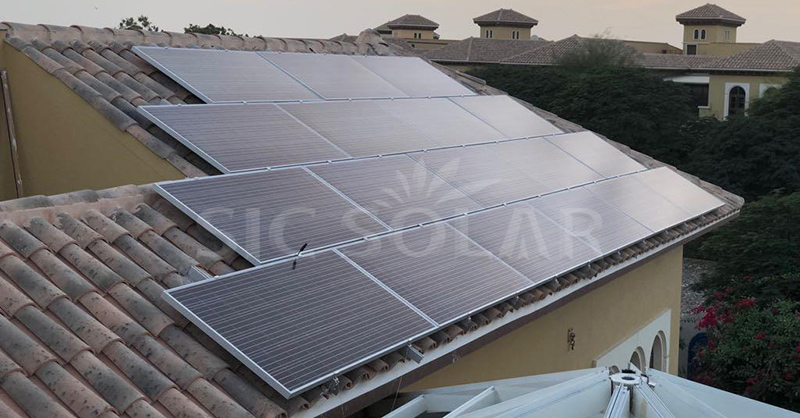
Bạn đang tìm kiếm điều gì?
 Tiếng việt
Tiếng việt
Mái ngói phổ biến ở nhiều vùng, được biết đến với vẻ ngoài cổ điển và độ bền tuyệt vời. Việc lắp đặt tấm pin mặt trời trên mái ngói đòi hỏi phải có kế hoạch cẩn thận để bảo vệ cả ngói và tính toàn vẹn chống thấm nước của mái nhà. Với các kỹ thuật và phần cứng phù hợp, có thể lắp đặt hệ thống năng lượng mặt trời đáng tin cậy, bền lâu mà không ảnh hưởng đến cấu trúc hoặc tính thẩm mỹ của tòa nhà.

Trước khi lắp đặt, mái nhà phải được kiểm tra kỹ lưỡng để xác nhận kết cấu của mái nhà chắc chắn và không có ngói vỡ. Một người lắp đặt có trình độ sẽ đánh giá:
Loại gạch (bê tông, đất sét, đá phiến)
Độ dốc và hướng mái nhà
Điểm truy cập cho hệ thống dây điện và biến tần
Do gạch có thể nứt dưới áp lực nên người lắp đặt phải sử dụng các công cụ và phương pháp chuyên dụng để tránh hư hỏng trong quá trình lắp đặt.
Đánh dấu bố trí
Bước đầu tiên là đánh dấu vị trí các giá đỡ và thanh ray sẽ được đặt. Người lắp đặt sẽ định vị các thanh xà bên dưới các viên ngói, vì những thanh gỗ chắc chắn này sẽ giữ chặt các giá đỡ.
Nâng hoặc Tháo Gạch
Các viên ngói được nâng lên hoặc tháo ra tạm thời tại các vị trí sẽ neo giá đỡ. Điều này đảm bảo màng mái vẫn nguyên vẹn và cho phép tiếp cận xà mà không làm vỡ các viên ngói.
Lắp đặt giá đỡ
Các giá đỡ chuyên dụng được cố định vào xà nhà bằng bu lông thép không gỉ. Các giá đỡ này được thiết kế để nâng các tấm lên trên ngói, tạo luồng không khí và ngăn áp lực lên bề mặt mái. Khu vực xung quanh giá đỡ được bịt kín bằng miếng đệm cao su hoặc miếng đệm cao su để tránh rò rỉ.
Thay thế và cắt gạch
Sau khi giá đỡ được cố định, các viên gạch được thay thế. Đôi khi chúng phải được cắt hoặc khía để vừa khít xung quanh phần cứng lắp mà không tạo ra khoảng trống.
Gắn thanh ray và khung
Thanh ray nhôm được lắp theo chiều ngang trên các giá đỡ, tạo thành một khung chắc chắn để giữ các tấm. Các thanh ray được điều chỉnh để đảm bảo chúng cân bằng và song song.
Bảo vệ các tấm pin
Sau đó, các tấm pin mặt trời được nâng lên vị trí và kẹp chặt vào thanh ray bằng kẹp giữa và kẹp cuối. Các kết nối điện được hoàn tất và các biện pháp nối đất được đưa ra để đáp ứng các tiêu chuẩn an toàn.
Vì mái ngói mỏng manh hơn so với mái lợp kim loại hoặc mái lợp nhựa đường, nên việc sử dụng hệ thống lắp đặt chuyên dụng, chất lượng cao là điều cần thiết. Các hệ thống này phải được thiết kế để:
Phân bổ trọng lượng đều trên các thanh xà
Ngăn ngừa gạch bị nứt
Cung cấp khả năng chống ăn mòn lâu dài
Năng lượng mặt trời SIC , một nhà sản xuất và cung cấp chuyên nghiệp các giá đỡ lắp đặt quang điện, cung cấp nhiều giải pháp cho việc lắp đặt mái ngói. Bộ dụng cụ lắp đặt của họ bao gồm móc ngói có thể điều chỉnh, thanh ray và kẹp được thiết kế để phù hợp với hầu hết các loại ngói. Hệ thống của SIC Solar được làm từ nhôm anodized và thép không gỉ, mang lại độ bền và độ chắc tuyệt vời trong điều kiện thời tiết khắc nghiệt.
Luôn thuê những người thợ chuyên nghiệp có kinh nghiệm làm việc với mái ngói.
Đảm bảo tất cả các lỗ thủng đều được bịt kín đúng cách để tránh rò rỉ.
Lên kế hoạch để dễ dàng bảo trì trong tương lai bằng cách chừa đủ khoảng cách giữa các hàng.
Sử dụng phần cứng chất lượng cao được thiết kế riêng cho việc lắp đặt gạch.
Việc lắp đặt tấm pin mặt trời trên mái ngói đòi hỏi sự cẩn thận hơn, nhưng với các kỹ thuật và hệ thống lắp đặt phù hợp, bạn có thể tạo ra một hệ thống năng lượng mặt trời hấp dẫn, hiệu quả, có thể tạo ra năng lượng sạch trong nhiều thập kỷ.